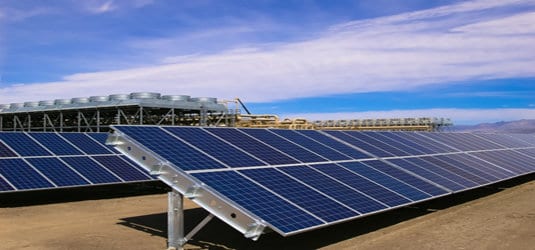Australia should develop new solar thermal projects within the mining industry to power mineral processing facilities, experts have told an industry conference.
Industry figures and researchers gathered at the Australian Concentrating Solar Thermal (ASTRI) conference in Melbourne to discuss the future of concentrated solar thermal (CST) in Australia.
Several points were made about the direction CST should be taken, but there was general agreement from speakers and from the floor that the focus on solar thermal had been too narrowly focused on electricity generation, without enough attention to its potential to provide heat for industrial use.
Swinburne University Pro-Vice Chancellor Geoffrey Brooks, who heads the Future Manufacturing department, said CST could be used “wherever you need heat,” and an obvious example was in the mining sector and processing minerals.
“My argument is, Australia’s ores are directly next to where the sun is hottest, so why not process the ores where the sun is, or where they happen to be digging them up,” he said.
“Instead of shipping ore out [for export,] we could ship metal out [at a much higher value.]
Prof Brooks is already working with mining companies on the concept.
Another researcher looking at the CST for mineral processing is University of Adelaide Centre for Energy Technology director Gus Nathan.
Prof Nathan and his research are part of ASTRI and he is collaborating on a project with alumina processing company Alcoa to use solar thermal to provide the extreme heat needed at its facilities.
“Within the minerals processing sector, we see a critical opportunity for Australia,” he said.
He said Australia’s major disadvantage in cost competitiveness in minerals processing could be largely overcome by harnessing solar thermal energy to provide the heat necessary for processing.
“We are competing against international low cost competitors, who may not have the same environmental standards,” he said.
“Currently, there is no market for higher value commodities, but we can anticipate that with the signing of the Paris accord, in the future there will be a greater market for higher value products which are guaranteed to be lower carbon.
“So this is where for Australia, it now may be more economic to make use of not only our high renewable resource, but also our strong certification system.”
Prof. Nathan said the most likely pathway to succeeding with CST for mineral processing would be a hybrid system using solar thermal, but backed up with some type of solar fuel.
Bringing the industry together
ASTRI is driven by CSIRO and brings together researchers from across Australia for targeted research on concentrated solar thermal energy. The program aims to bring the cost of solar thermal energy down to 12 cents per kilowatt hour by 2020.
The conference gave companies and stakeholders in the solar thermal sector a chance to hear about the status of projects by ASTRI and the wider industry.
Energy storage: the great advantage of thermal
University of South Australia Professor of Sustainability and Engineering Wasim Saman told the conference the great advantage of CST as a renewable energy was its storage potential, particularly the ability to control its dispatchability.
As part of ASTRI, Prof. Saman has been researching techniques for storing thermal energy and the best materials to use at temperatures ranging from 400°C to 700°C, including molten salts.
“A number of suitable materials have been found,” he said.
“We have done a lot of testing and we are beginning to feel that we have an improved value proposition from the system that we are looking at.”
Prof. Saman said the ASTRI program had shown the cost of storing thermal energy could be as low as $A20 per kilowatt hour.
FACTBOX
Some key points raised
- Strong support for developing the use of super critical CO2 as a storage device with solar thermal
- Energy storage is an advantage for CST that must be explored
- Solar thermal projects can tie in with developing solar fuels and sustainable liquid fuels
- Research is underway into a wide range of materials to store heat from CST
- Smaller plants offer a better chance of gaining investment and getting it right.







